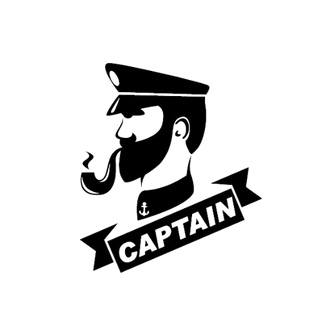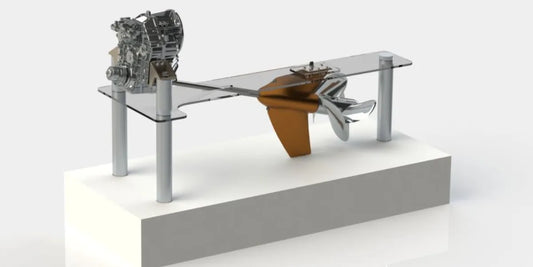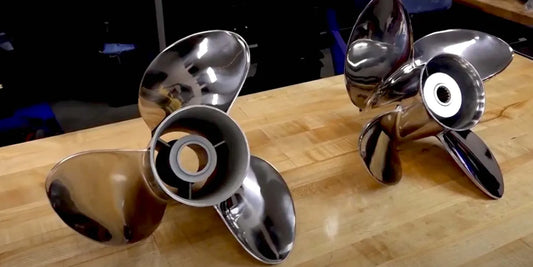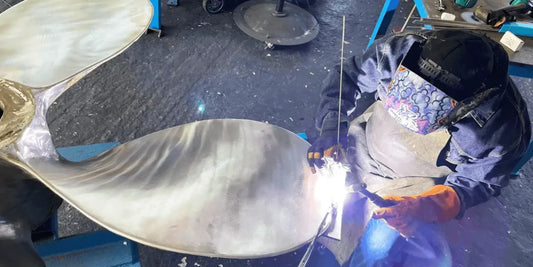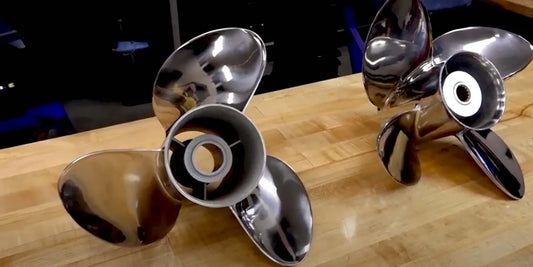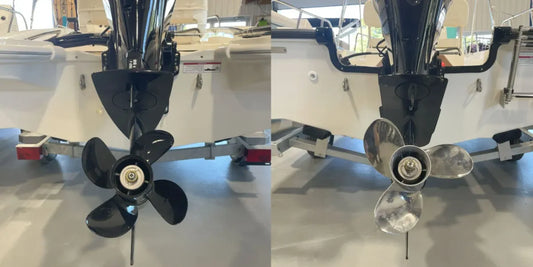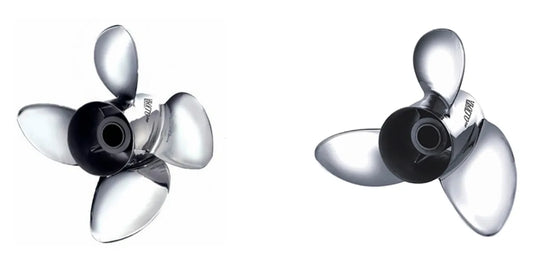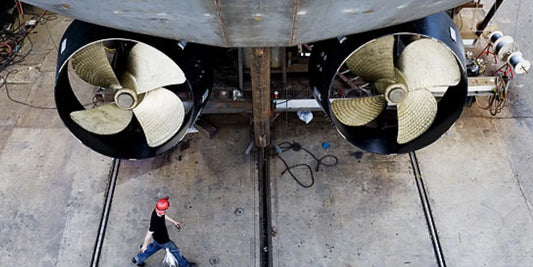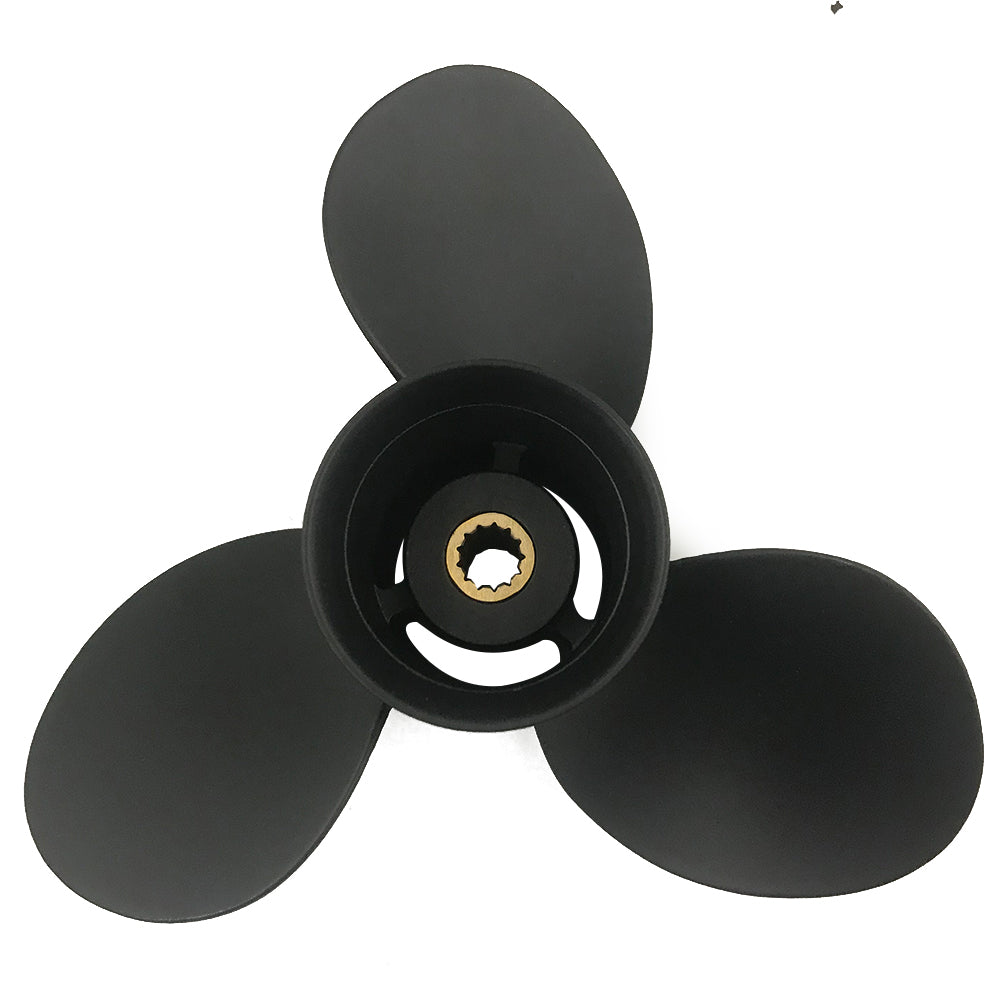Selecting the perfect propeller can make or break marine or aviation performance. One of the most heated topics in this industry is the comparison between the 4-blade and the 3-blade propeller. Are 4 or 3 blades better? This depends on production efficiency related to speed, stability, and safety, as well as on your specific vessel or aircraft and the demands placed upon it. This article lays out a thorough explanation of the technical and practical differences between the two kinds of propellers so that you can decide wisely based on the goal of performance and end-use requirements. Whether you seek to maximize acceleration, smooth out handling, or attain a balanced mixture of speed and fuel efficiency, this article is intended to provide you with a wholesome discourse through which you might make your choice with confidence. So, go ahead and read. With some important takeaways for you to absorb, you will be able to raise your level of understanding—and elevate your performance."
Introduction to Propeller Types

What is a Propeller?
A propeller is a mechanical thrusting device used to propel a vehicle, such as a boat, an airplane, or a drone, through the fluid medium, water or air. It consists of a central hub with two or more blades extending outward in a helical form. When the propeller rotates, it creates an area of low pressure in front of it by accelerating the fluid behind it, thereby moving the vehicle forward. Modern propellers are manufactured and tested for performance to save energy and reduce noise, making them indispensable in any industry. The blade count, the material it is made from, and the diameter are all carefully selected based on the specific needs and applications of the propellers.
Importance of Blade Design in Propellers
Propellers, which provide thrust or energy for the movement of vessels, need to be designed with a complete understanding of performance. Parameters such as blade shape, pitch, and surface area affect the thrust a propeller imparts, its fuel efficiency, and its noise level when operating. High-performance designs, for instance, incorporate tapered and twisted blades to maximize thrust in water or air by maintaining an equal pressure distribution along the blade length.
Advanced materials have provided modern propeller blades with even better strength-to-weight ratios and durability. Computational fluid dynamics (CFD) modeling and 3D printing allow blade design to be perfected for hydrodynamic and aerodynamic performance. Also, coatings may be applied to reduce drag further and provide wear resistance against corrosive environmental conditions, thus extending propeller life. Using such technology creates an ideal path toward better marine, aviation, and industrial performance through the tailored design of propeller blades.
Overview of 3-Blade versus 4-Blade Propellers
A 3-blade propeller and a 4-blade propeller function differently in various applications, with their design properties adapted to performance and efficiency requirements.
3-Blade Propellers are used when a balance between speed and fuel efficiency is desired. Being less draggy than the multi-blade sets, these are suitable for fast vessels or aircraft. This arrangement creates direct and indirect cost benefits for better propulsion efficiency while minimizing drag resistance against water or air due to the lesser blade area. On the other hand, noise and vibrations are slightly higher, which adversely affects comfort in specific sensitive applications.
The 4-Blade Propellers are known to deliver smooth power, especially in settings where load-carrying capability is paramount. The extra blade reduces vibration and noise, enhancing user comfort. These propellers generally provide excellent stability in water or air, offering grip and incredible maneuverability —very useful for heavy-duty vessels like tugboats or in aircraft that require enhanced performance during short takeoff and landings. But being larger in blade surface area means slightly more drag, which might be a problem for top speed and overall fuel efficiency.
If an establishment requires more cruising tack times or performs extreme maneuvers, the vessel should be equipped with a four-blade propeller system. Usually, increasing the number of propeller blades found on the propeller raises the load-carrying capacity of the propeller and thus increases vibrational thrust in the water. This is what makes a 4-blade propeller superior: it cancels much of the vibration caused by a 3-blade propeller, which would otherwise increase noise and discomfort for passengers. Such propellers would offer more stability in water or air for grip and maneuverability, making them excellent for heavy-duty vessels like tugboats or aircraft that require enhanced performance during short takeoffs and landings. However, the drag created by the increasing blade surface area might be somewhat high, which in turn could limit top speed and overall fuel efficiency.
During a determination, depending on the two configurations, operational considerations, performance priorities, noise tolerance, fuel efficiency, and other factors would be maximized. Speed-oriented applications could prefer 3-blade designs, while stability-oriented operations may prefer weight-loaded 4-blade configurations. New materials and manufacturing processes continue to improve the parameterization capabilities of both designs, allowing them to be used in nearly every industry.
3-Blade Propeller Characteristics

Design and Functionality of 3-Blade Propellers
The three-blade propeller maintains widespread usage through diverse commercial industries due to its balanced design and flexibility. The three-blade setup allows a balanced compromise between thrust efficiency and fuel consumption, making it well-suited to mediums requiring moderate power and speed capabilities. In most cases, three-bladed propellers can be lighter and less expensive than their competitors with more blades, thus favoring efficiency; this fact becomes vital in an environment where efficiency spells the difference.
In terms of functionality, 3-blade propellers have benefited from many recent developments in aerodynamics and materials engineering. Improved blade configurations, including variations in curvature and increasingly thin airfoils, serve to reduce drag and noise and maximize thrust development. Materials such as carbon composites enjoy increased favoritism by virtue of being light and very durable, enabling the blades to resist very high rotational speeds and harsh operating conditions. Again, the vibration levels of such propellers are reduced for greater operational stability and user comfort.
Performance testing shows that 3-blade propellers perform best when speed and economy are balanced. In this regard, forts, aviation, and maritime industries use this design for small- to medium-sized aircraft and vessels. Also, one can easily modify a 3-blade propeller for specific performance requirements, such as high RPM or low load, outside of other design parameters. These improvements continue to enhance the practical use and versatility of 3-blade propellers in various technical and commercial settings.
Performance Advantages of 3-Blade Propellers
Three-blade propellers present an almost ideal trade-off between thrust and efficiency, making them a preferred choice for all industries. The fewer the blades, the less the drag experienced; therefore, the 3-blade propeller faces less drag than a 4-blade propeller, increasing its efficiency and hence fuel economy. The design also allows it to revolve at a high speed, thereby improving performance in application areas that need fast propulsion. In another sense, 3-blade propellers are optimized to be quieter than other designs so that noise emission is kept to a minimum-for the greater benefit of the environment and residential areas.
An important feature from an engineering standpoint is that 3 blades are structurally designed to reduce engine strain while maintaining thrust power. Thus, an engine will last longer and cost less to maintain. For instance, modern computational models prove that 3-bladed propellers reach the maximum delivery of thrust within the medium-speed range, making them appropriate for lightweight planes, private boats, or even drones. Their customizable nature allows manufacturers to optimize blade angle and blade material to suit their operational requirements, ensuring consistent and reliable performance.
Common Applications for 3-Blade Propellers
Since these propellers find a good balance between efficiency, thrust, and adaptability, they are generally used in various industrial fields. The three-blade propeller is, for example, widely used in light aircraft where maximum thrust is realized at mid-speeds, thus ensuring smooth and dependable airborne performance, keeping noise levels down. Private boats and recreational watercraft also favor 3-blade propellers as they provide consistent thrust while granting enhanced maneuverability in shallow or calm waters. And 3-blade propellers are also highly favored in the drone world as they impart more stability during flight and better control for precision operations such as aerial photography or surveying. Advances in materials have further improved these applications; for instance, low-weight composites help reduce drag and enhance durability, making them essential for almost any transportation- and operation-level application. Due to their versatility and reliability, 3-blade propellers see a broad scope of applications in modern-day engineering solutions.
4-Blade Propeller Characteristics

A Different Look and Function With 4-Blade Propellers
4-blade propellers were each built for performance enhancements, especially when power and stability are of prime consideration. An additional blade means a larger surface area for the propeller, which allows smoother operations and minimizes vibrations, enhancing precision and comfort for both boats and airplanes. They are used in assignments requiring maximum thrust yet minimum noise, like commercial jetliners and high-end pleasure crafts.
The design typically aims to counterbalance to minimize the trade-off between speed and efficiency. Increased blade area can, however, slightly reduce top-end speed as compared to 3-blade designs and improve the low-speed handling, making 4-blades a good choice for maneuvering under difficult conditions. CFD is commonly used, along with advanced materials like carbon composites and titanium alloys, to achieve high performance and durability in modern propellers.
Furthermore, 4-blade configurations are better at preventing thrust fluctuations and cavitations that occur mainly in high-stress environments such as high-speed marine operations. The load distribution helps 4-blade propellers provide more protection to the engines they are coupled with. In fields such as military transport and industrial transportation, 4-blade propellers have found an increasing sphere of application due to their ability to combine power and efficiency, providing an almost perfect solution for any heavy-duty application.
Performance Advantages of 4-Blade Propellers
Four-blade propellers provide excellent maneuverability and enhanced stability, especially at slow speeds, when precise steering qualities are required in military and rescue applications. These propellers vibrate less compared to their 2 and 3-blade counterparts, ensuring smoother and quieter operation. Less vibration increases comfort levels for the user and reduces wear and tear on engine parts, which eventually leads to a longer life for the equipment.
Apart from that, four blades will produce more thrust under heavily induced loads or disturbances due to their excellent reliability. There are industrial sectors where uninterrupted performance is genuinely essential in challenging situations. Hydrodynamic efficiency studies have shown that four-blade designs confer better torque loss resistance, allowing for the continuous delivery of power, which is crucial in pressure-prone scenarios under cargo and offshore applications. Nevertheless, with their optimization in geometry and the introduction of new materials, modern 4-blade propellers are continually developing to meet the mounting demands of efficiency and power in multifarious applications.
Typical Applications of 4-Blade Propellers
They are widely used in marine and industrial applications because these 4-blade propellers provide more thrust and stability. In large cargo ships, this design is almost preferred-for efficient propulsion even when carrying heavy loads. Offshore vessels, such as those used for oil and gas exploration, would prefer a 4-blade type because it will continue to perform reliably under high pressure and rough sea conditions, allowing the vessel to remain under control and minimize vibration.
Recreational boats and yachts benefit from the smooth application of 4-bladed propellers at cruising speeds to assure general fuel efficiency. Naval and military ships also use these types of propellers for their quiet operation, which is highly desirable in providing precise maneuvering during tactical operations. With further developments in materials and engineering, these propellers are increasingly considered for incorporation on ships requiring high-performance and low-noise solutions, making them truly versatile to cater to many maritime needs.
Comparative Analysis: 3-Blade vs 4-Blade Propellers

Blade Area and Efficiency
The propeller's blade area is a decisive factor in its overall performance and efficiency. Then a 4-blade propeller, with a larger surface area, lovingly offers smooth operation and good thrust at lower speeds. Hence, they can be used with good stability for vessels under heavy loads through rough conditions. On the contrary, the smaller the blade area of a 3-blade propeller, the higher the top-end speed and the better the fuel performance due to reduced drag.
The two features can be balanced, depending on the specific use. For instance, recreational boats generally prefer 3-blade propellers because they allow higher speeds with lower fuel consumption. Commercial vessels or those engaged in work requiring handling in rivers should ideally benefit from the superior control and efficiency provided by 4-blade propellers, especially in rougher waters.
With CFD and testing methods progressively optimized, both blade types have become increasingly fine-tuned for blade shape, pitch, and overall performance. For example, modern materials like carbon composites impact the lightness and strength of propellers, and hence the efficiency of both 3-blade and 4-blade configurations. With such improvements, the selection between the two types can be fitted to the somewhat varying requirements of the sea operations.
Merchant Ventilation and Cavitation Are Critical Factors
Ventilation and cavitation are key phenomena in marine propeller performance, with each affecting the efficiency and longevity in operation. Ventilation is a phenomenon where air, usually from above or caused by a sudden change in flow velocity, is dragged into the propeller blades. The effect is the introduction of air pockets on the blades, lessening thrust and efficiency. The modern designs usually aim to reduce this air intrusion by designing blade profiles more critically and using typically deeper shaft alignments, particularly in cases of high-speed vessels.
Cavitation, by contrast, occurs when the water pressure around the propeller falls below its vapor pressure, causing the formation of vapor bubbles that then collapse on the blade surfaces. These collapses cause shock waves, erosion, noise, and vibration that reduce performance and life. Advanced computational fluid dynamics (CFD) cavitation simulation models predict the phenomena. In an attempt to mitigate these effects, blade geometry is modified to minimize low-pressure zones. Additionally, surface coatings and materials with greater erosion resistance are increasingly employed to prolong the service life of the propeller.
All this multiplicatively contributes to undertaking more in-depth research into ventilation and cavitation to improve propeller design, enabling vessels to maintain efficiency under various conditions while requiring virtually no maintenance. This reflects a constant commitment to reliability and sustainability of marine propulsion arrangements.
Diameter and Pitch Considerations
There are two primary elements affecting vessel performance, fuel consumption, and propulsion efficiency: propeller diameter and pitch. Depending on the diameter of the propeller, different amounts of water will be set into motion. Larger diameters tend to favor better propulsion efficiencies at lower speeds by minimizing slip and delivering thrust optimally. Vessel size, engine power considerations, and clearance requirements do, however, provide some practical restrictions on the diameter that may be used.
Pitch denotes the distance a propeller would theoretically advance in one complete turn, excluding slip. The speed and power transferred between the shaft and the propeller can be balanced by adjusting the pitch. For fast vessels, a lower pitch may be chosen to accelerate quickly and limit cavitation, while a higher pitch favors maximum speed when cruising at steady-state, and vice versa. This combination can only be developed through proper analysis and testing of vessel design, operational profile, and hydrodynamic profile.
Recent developments in computational methods and propeller prototyping techniques have advanced the ability to determine and evaluate diameter and pitch configurations for achieving the optimum solution for any particular maritime application. This truly emphasizes the need for a systematic approach in the design of propellers to achieve maximum performance while ensuring operational sustainability.
Choosing the Right Propeller for Your Boat

Factors to Consider When Choosing Between 3 or 4 Blade Propellers
Selecting the right propeller for your boat is arguably the most crucial choice affecting performance, fuel efficiency, and ease of handling. Understanding the factors that distinguish 3-blade and 4-blade propellers can guide you in deciding for your boating needs.
1. Speed and Performance: Generally, a 3-blade propeller will be favored when higher speeds and top-end performance are demanded. The design of the propeller reduces drag, making it the propeller of choice for recreational-class boats and vessels requiring racing-level velocity. The 4-blade propellers, on the other hand, will help with acceleration and hold the speeds better when heavy loads or rough conditions are present. Along these lines, it serves well for towing sports or commercial jobs that require traction most of the time.
2. Fuel Efficiency: As of cruising speed, 3-blade propellers are designed to lower resistance and therefore have better fuel economy. Four blades, on the other hand, come in handy to provide a more stable thrust and thus are more efficient at slow speeds, particularly in strong-current or turbulent-water situations.
3. Handling and Stability: Going out on the big, rough, open sea or maneuvering through tight corners, yes, handling and stability do become important. A 4-blade propeller runs more smoothly and is more controllable; vibrations are reduced, ensuring steady performance. That is why it is classified as a desirable one to specify for fishermen and those operating in narrow channels.
4. Load-Carrying Capacity: If your boat often carries heavy loads or a large number of passengers, then 4-blade propellers are better for such conditions. They distribute thrust more evenly, allowing the boat to lift and plane with more ease under heavy load.
5. Cavitation and Ventilation: With the onset of higher speeds, cavitation or ventilation comes on with 3-blade props. As against that, the 4-blade propellers are designed to reduce cavitation and ventilation-proper thrust and resistance-propeller wear, therefore-propeller sustainability over time.
6. Application and Use Case: The intended use of the vessel defines it. For speedboats or lightweight crafts prioritizing velocity, the 3-blade mode is generally better. Conversely, the 4-blade propeller means better hold and low-speed control on boats designed to be stable, such as pontoons or boats towing water skiers.
7. Propeller Diameter and Pitch: Diameter and pitch are paramount in determining whether a boat is suitable for either type of propeller. Ideally sized propellers with 3 or 4 blades maximize the engine's efficiency, protecting it from being overloaded or underloaded. Manufacturers of your boat may have recommendations, and it is wise to consult them to finalize the best setup for your engine and its application.
Weighing all these factors will equip you to make the right propeller choice, ensuring the perfect working compromise between speed, stability, efficiency, and performance in your operation.
Effects of Boat Type and Use Upon Propeller Selection
In terms of picking the ideal boat prop for my vessel, I've learned that the nature of the boat I operate and its intended application form crucial parameters in making an apt choice. Different types of boats —fishing, pontoon, or performance speedboat—have their own demands regarding the size and design of the propeller. For example, a fishing boat working in shallow waters requires a propeller skewed towards a balance of thrust and maneuverability. In contrast, a performance boat works well with a highly pitched propeller that offers fast acceleration and top-end speed.
Other than boat type, how I utilize the vessel has to be taken into account. For leisure cruising, all-around propellers designed for smooth rides and efficiency will be ideal. In contrast, water skiing or wakeboard towing requires low-speed power for the propeller to cope with the additional strain. Other considerations would be whether I often boat amidst calm lakes or rough offshore conditions, as there is a greater demand for design durability and stability in harsher environments.
At the very bottom of it, choosing the perfect propeller starts with evaluating the work my boat does, trying to match those requirements with the technical specifications of different propellers. I make sure to take into account things such as pitch, material, and blade count, along with the manufacturer's recommendation. Also, according to this, I can enhance the performance of my boat during a joyride, some water activities, or fishing, until I'm really typing out my long-term assurance.
Expert Recommendations for Propeller Selection
When considering the selection of a propeller, I rely on essential factors to align it with my performance goals and the particular needs of the boat. Firstly, I study the pitch and diameter of the propeller; these two are key factors that determine the speed and thrust efficiency. A lower pitch accelerates a heavier boat or one that is towing, while a higher pitch is suitable for attaining the best top speed for a lighter boat. Another factor to consider is the maximum RPM range allowed for the engine by the manufacturer. If the propeller pitches are not set to match the recommended engine RPM range, depending on the pitch, underloading or overloading of the motor can occur, leading to wear and inefficiencies.
Material considerations will rest on another significant part of this decision process for me. Stainless-steel propellers offer durability and performance with their rigidity, making them preferred for high-performance boating ventures or in intense current situations. Aluminum propellers are cost-effective and good enough for recreational boating in calm waters. Depending on my day's work, whether for occasional fishing, watersports, or cruising, I balance durability and affordability to ensure a reasonable investment.
Finally, I look into the number of blades and their design. Three-blade propellers tend to allow greater top speed, whereas the four- or five-blade types enhance turning and acceleration, useful for watersports and hefty loads. For precision, I then check manufacturer charts and consult propeller dealers to cross-check the data, ensuring that my choice of a propeller corresponds with the design of the boat hull and its intended use. This way, we get the best out of both performance and engine life.
Reference Sources
3 Blade vs. 4 Blade Propeller - Michigan Wheel
3-Blade vs. 4-Blade Propeller: What Are The Differences? - Reel Coquina Fishing
Which Prop is Better For Your Boat: 4 Blades or 3 Blades? - BoatTest
2-, 3- or 4-blade folding propeller – What to Choose for Your Sailboat - Flexofold Blog
What's the Difference Between 2, 3, and 4-Bladed Propellers? - Airplane Academy
Frequently Asked Questions (FAQs)
What constitutes the superiority of the 4-blade propeller over a 3-blade propeller?
Because of its excellent handling capabilities, a 4-blade propeller offers a smoother ride in rough water conditions than a 3-blade prop. Having one more blade increases the surface area, improving the hole shot and maintaining higher speeds. This additional blade reduces vibration and slip, making it more favorable for recreational boats needing stability. Fuel mileage can be improved by using the 4-blade design, which could entail making more efficient use of the engine's power at certain rpms. It would therefore appear that if the goal is high performance, a 4-blade would get you there.
How do these blades affect the performance of boats?
Boat performance is significantly influenced by the number of blades, especially regarding torque and acceleration. The high top speed that a 3-blade propeller can achieve is due to the less drag it produces, whereas a 4-blade propeller maintains low speed and provides stability. In other words, depending on whether it is for a rough sea condition or a better hole shot, the choice could lean toward a 4-blade western prop. The 3-blade prop, on the other hand, will welcome maximum speed at higher rpm and efficiency. The choice between 3- and 4-blades basically depends on what the boat is designed to perform.
Generally speaking, do 3-blade propellers give better fuel economy than their 4-blade counterparts?
Generally, if the speed range demands it, the 3-blade prop can better assist fuel economy, especially at higher speeds where less drag is involved. 3-blade props operate efficiently due to the lower surface area of the blade, especially when the boat is on plane. However, when low speed, acceleration, or other special conditions are the criterion, a four-blade may be more fuel-efficient, given it perfectly uses power and torque from the engine. So in this respect, depending on the boater's use cases, whether cruising or high-performance activities, preferences may remain different from person to person.
What effect do diameter and pitch have on a 3- and 4-blade prop?
Both diameter and pitch are major determinants of 3-blade and 4-blade propeller performance characteristics. A larger diameter increases surface area, which accelerates and creates more grip in the water for a 4-blade structure. The pitch, how far the boat moves with each rotation of the prop, can trade acceleration for top speed. In the case of either the 3-blade or the 4-blade prop, the appropriate balance between diameter and pitch is the key to maximum speed and proper performance at various rpms.
Would a 3-blade or 4-blade prop be better in rough water conditions?
Most 4-blade propellers are usually preferred for rough waters. The extra blade is an additional factor that generates stability and hence provides better control of the boat. A more significant number of operations can be performed in choppy waters. Waves and currents are usually cast off this stability as it prevents the boat from losing so much grip. Moreover, 4-blade propellers are not very prone to ventilation, which is an unfortunate circumstance when a propeller is somewhat exposed to air. On the other hand, while 3-blade props can definitely hit higher speeds, they may just not give that same level of handling capability when conditions get tough.
How does a 4-blade propeller affect the hole shot compared to a 3-blade prop?
A 4-blade prop is generally considered to have better hole shot performance over a 3-blade prop. The extra blade yields additional thrust in lower RPM regimes, allowing faster acceleration and quicker plane-setting of the hull. This will be a plus while activities involving rapid acceleration, such as towing or water sports. To be fair, 3-blade props also accelerate well but probably not as briskly as 4-blades props under similar scenarios. Thus, the 4-blade prop is usually recommended for those looking for speedy take-off performance, especially in lower RPMs.
